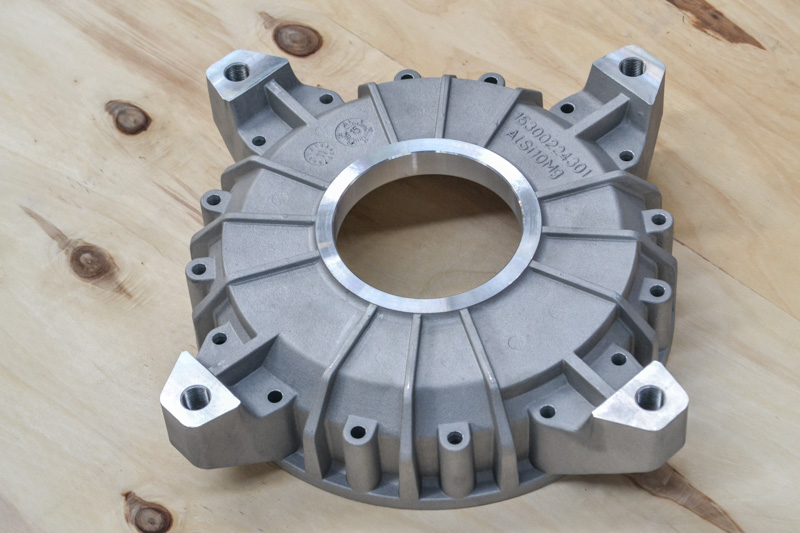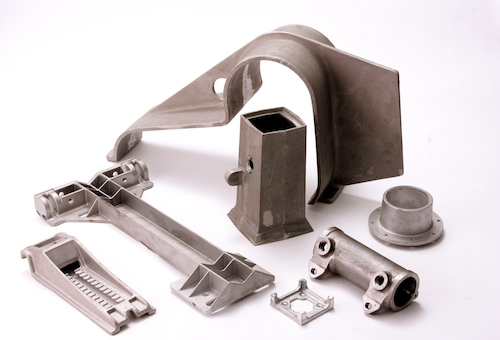Checking Out the Versatile Makes Use Of and Applications of Aluminum Castings in Modern Industries
Aluminum spreadings have ended up being integral to various contemporary markets because of their unique residential properties. They use significant advantages in weight reduction, thermal conductivity, and corrosion resistance. From auto advancements to applications in consumer items and building and construction, their flexibility is amazing. Yet, the real degree of their impact extends beyond instant advantages, hinting at broader effects for sustainability and performance. What lies ahead for light weight aluminum spreadings in an ever-evolving industrial landscape?
Automotive Market Innovations
The vehicle industry has significantly accepted light weight aluminum castings to boost vehicle performance and effectiveness. By making use of light weight aluminum, manufacturers can generate lighter parts, which contribute to enhanced fuel economic situation and reduced exhausts. Key applications include engine blocks, transmission instances, and architectural components, where the product's strength-to-weight proportion supplies durability without including excess weight.
Aluminum castings also offer superior thermal conductivity, which helps in better heat dissipation, thereby boosting engine performance. Advancements in casting modern technologies, such as die spreading and sand spreading, make it possible for the manufacturing of complex geometries, enabling for innovative designs that enhance room and capability.
The recyclability of light weight aluminum straightens with sustainability objectives in the vehicle industry, advertising eco-friendly methods. As the market remains to innovate, the usage of light weight aluminum castings is most likely to expand, driving more developments in lorry layout and effectiveness.
Aerospace Applications and Advancements
While the aerospace market remains to prioritize weight reduction and gas effectiveness, light weight aluminum spreadings have arised as an essential product choice for different applications. Their light-weight nature, paired with high strength-to-weight proportions, permits for considerable renovations in airplane performance and performance. Aluminum castings are generally utilized in architectural elements, such as fuselage structures and wing parts, where reducing weight is important.
Recent advancements in light weight aluminum spreading technologies, including enhanced alloy formulations and accuracy casting methods, have better boosted the product's efficiency capacities. These developments make it possible for the production of intricate geometries and elaborate styles while preserving architectural stability. Additionally, aluminum's superb corrosion resistance guarantees long life and reliability in extreme aerospace atmospheres.
As the aerospace field increasingly welcomes sustainability, aluminum spreadings use a recyclable solution that lines up with environmentally friendly practices, making them an essential component in the growth of next-generation airplane.
Durable Goods and Everyday Products
As consumers increasingly seek lightweight yet sturdy products for day-to-day products, light weight aluminum castings have acquired appeal in numerous customer products. The distinct residential properties of light weight aluminum, including its resistance to corrosion and excellent thermal conductivity, make it an optimal option for products like pots and pans, household home appliances, and outdoor gear. As an example, aluminum cast pots and pans supply even heat circulation, boosting cooking effectiveness. Additionally, the use of aluminum in things such as bicycle structures and luggage guarantees a balance between stamina and mobility. Manufacturers appreciate light weight aluminum spreadings for their adaptability, as they can be easily built into complex shapes while maintaining architectural stability. The ability to recycle light weight aluminum without weakening its residential properties straightens with growing customer choices for sustainable products. On the whole, light weight aluminum spreadings are indispensable to the production of long lasting, useful, and cosmetically pleasing customer goods, fulfilling the needs of modern-day lifestyles.
Construction and Architectural Uses
Aluminum castings have actually become a necessary part in building and architectural style, specifically as a result of their toughness and light-weight nature. These homes make aluminum an ideal selection for numerous applications, consisting of architectural components, exteriors, and ornamental functions - Aluminum Foundry. Architects and contractors progressively make use of aluminum castings for home window structures, doors, and roof systems, improving both capability and looks. The product's resistance to deterioration better extends its lifespan, decreasing upkeep expenses and making certain resilience in diverse ecological problems
Aluminum can be conveniently built right into detailed layouts, permitting for cutting-edge building expressions. Its convenience promotes the production of personalized items that satisfy certain layout requirements, from elaborate railings to complex assistances. As sustainability comes to be a concern, light weight aluminum's recyclability includes to its charm in environment-friendly building methods. Overall, aluminum castings are transforming the construction sector by supplying lightweight, durable, and aesthetically attractive solutions.
Digital and electrical Elements
Aluminum castings play an essential function in the manufacturing of lightweight electric rooms, which enhance transportability and effectiveness in numerous applications. On top of that, their exceptional thermal conductivity makes them optimal for heat sinks, making certain peak performance and long life of electronic elements. Aluminum's conductive properties contribute to its usage in numerous electrical conductors, highlighting its relevance in modern innovation.
Lightweight Electrical Rooms
Light-weight electrical enclosures play a necessary duty in safeguarding delicate digital components from environmental elements and physical damages. Created from light weight aluminum castings, these units are valued for their strength-to-weight proportion, making them excellent for different applications throughout sectors. Their light-weight nature aids in reducing general system weight, which is crucial in mobile and mobile electronic devices. Light weight aluminum's deterioration resistance improves sturdiness, prolonging the life expectancy of the encased elements. The capacity to mold and mildew aluminum right into intricate forms permits for personalized styles, satisfying particular needs while ensuring effective warmth dissipation. In addition, these rooms can be quickly integrated right into existing systems, supplying flexibility and versatility in modern-day technical atmospheres. In general, lightweight light weight aluminum rooms considerably add to the effectiveness of electronic tools.
Warm Sinks and Conductors
While numerous products are made use of in electronic parts, light weight aluminum castings stand out for their performance in heat monitoring as warm sinks and conductors. Their outstanding thermal conductivity enables effective heat dissipation, which is crucial in avoiding the getting too hot of electronic tools. Aluminum's light-weight nature even more boosts its suitability for applications where weight is a substantial aspect, such as in aerospace and automotive markets. In addition, aluminum spreadings can be easily formed right into complex forms, providing design adaptability for optimizing thermal efficiency. The deterioration resistance of aluminum likewise adds to the longevity and dependability of these parts in various atmospheres. As modern technology advancements and gadgets come to be more small, the need for efficient warmth management services, like light weight aluminum spreadings, remains to grow.
Marine Industry Utilization
The marine market significantly counts on aluminum castings for their phenomenal resilience and rust resistance. These properties make aluminum a suitable selection for numerous applications, consisting of watercraft hulls, engine parts, and aquatic equipment. The light-weight nature of aluminum castings enables improved gas performance and less complicated ability to move in watercraft, which is important for both industrial and recreational vessels.

Aluminum castings likewise supply significant price benefits due to their long lifespan and reduced upkeep requirements, minimizing the overall operational expenses for aquatic drivers. Furthermore, the convenience of aluminum enables elaborate layouts that can satisfy certain performance requirements.
Makers in the aquatic industry make use of innovative casting strategies to generate complex shapes, making sure that parts satisfy extensive security and efficiency requirements. As the demand for high-performance aquatic vessels grows, light weight aluminum castings are placed as a key product in enhancing the functionality and durability of marine devices.
Sustainability and Recycling in Light Weight Aluminum Casting

Light Weight Aluminum Recycling Refine
Recycling aluminum plays a necessary duty in reducing environmental effect and saving sources within the spreading market. The light weight aluminum reusing procedure starts with the collection of scrap light weight aluminum, which can consist of old components, manufacturing waste, and post-consumer products. This scrap is then sorted, cleansed, and shredded right into tiny items to facilitate melting.
Once prepared, the aluminum scrap is melted in a furnace at lower temperature levels than key light weight aluminum manufacturing, substantially lowering power intake. The liquified light weight aluminum is then cast into ingots or other forms for reuse in numerous applications - Aluminum Castings. This closed-loop system allows for the reliable recuperation of light weight aluminum, protecting its buildings while lowering the requirement for virgin materials. Subsequently, the recycling process is an important element of sustainable techniques in light weight aluminum casting
Environmental Benefits
While light weight aluminum spreading plays an essential role in numerous markets, its environmental advantages are especially amazing regarding sustainability and source preservation. The light-weight nature of aluminum adds to power performance in transport, lowering gas usage and exhausts. Furthermore, aluminum casting facilitates the use of recycled products, greatly reducing the power required for production contrasted to primary aluminum. This recycling process reduces waste and reduces the environmental effect related to mining and refining resources. Light weight aluminum is 100% recyclable without degradation of its homes, promoting a sustainable lifecycle. By picking aluminum casting, industries can greatly lower their carbon footprint while advertising resource effectiveness, making it Aluminum Castings an important selection in the pursuit of eco pleasant manufacturing techniques.
Closed-Loop Solutions

Often Asked Inquiries
What Are the Secret Conveniences of Aluminum Castings Over Other Materials?
Light weight aluminum spreadings offer lightweight homes, outstanding corrosion resistance, and high strength-to-weight proportions. They can be conveniently built right into complicated forms, give great thermal and electrical conductivity, and are cost-effective, making them better over several different products.
How Is the Aluminum Casting Refine Ecologically Friendly?
The aluminum casting process is eco-friendly due to its recyclability, reduced energy consumption, and lowered waste manufacturing. Its ability to use recycled products reduces the carbon footprint, advertising sustainability within making techniques.
What Are Typical Obstacles in Aluminum Spreading Manufacturing?
Usual obstacles in light weight aluminum casting production include keeping dimensional precision, managing thermal contraction, stopping issues like porosity and inclusions, ensuring correct mold and mildew layout, and maximizing manufacturing efficiency while lessening material waste and environmental impact.
Exactly How Do Aluminum Castings Compare in Cost With Various Other Production Methods?
Light weight aluminum spreadings commonly supply affordable costs compared to other making methods, specifically for tool to high-volume production. Their reduced preliminary tooling costs and efficient material use can result in desirable business economics with time.
What Future Patterns Are Anticipated in Aluminum Spreading Innovation?
Future patterns in aluminum casting technology are prepared for to consist of advancements in automation, enhanced alloy structures, enhanced recycling techniques, and the integration of 3D printing, all focused on boosting performance, lowering prices, and lessening environmental impact.
Recent innovations in light weight aluminum spreading innovations, including boosted alloy formulations and accuracy spreading techniques, have actually even more boosted the product's performance capabilities. Light weight aluminum spreadings have come to be a vital element in building and construction and building style, particularly due to their strength and lightweight nature. The aluminum recycling procedure starts with the collection of scrap aluminum, which can consist of old elements, manufacturing waste, and post-consumer items. Once prepared, the light weight aluminum scrap is thawed in a furnace at reduced temperature levels than main aluminum manufacturing, significantly lowering power intake. Furthermore, aluminum casting facilitates the use of recycled products, substantially decreasing the power needed for production contrasted to primary light weight aluminum.